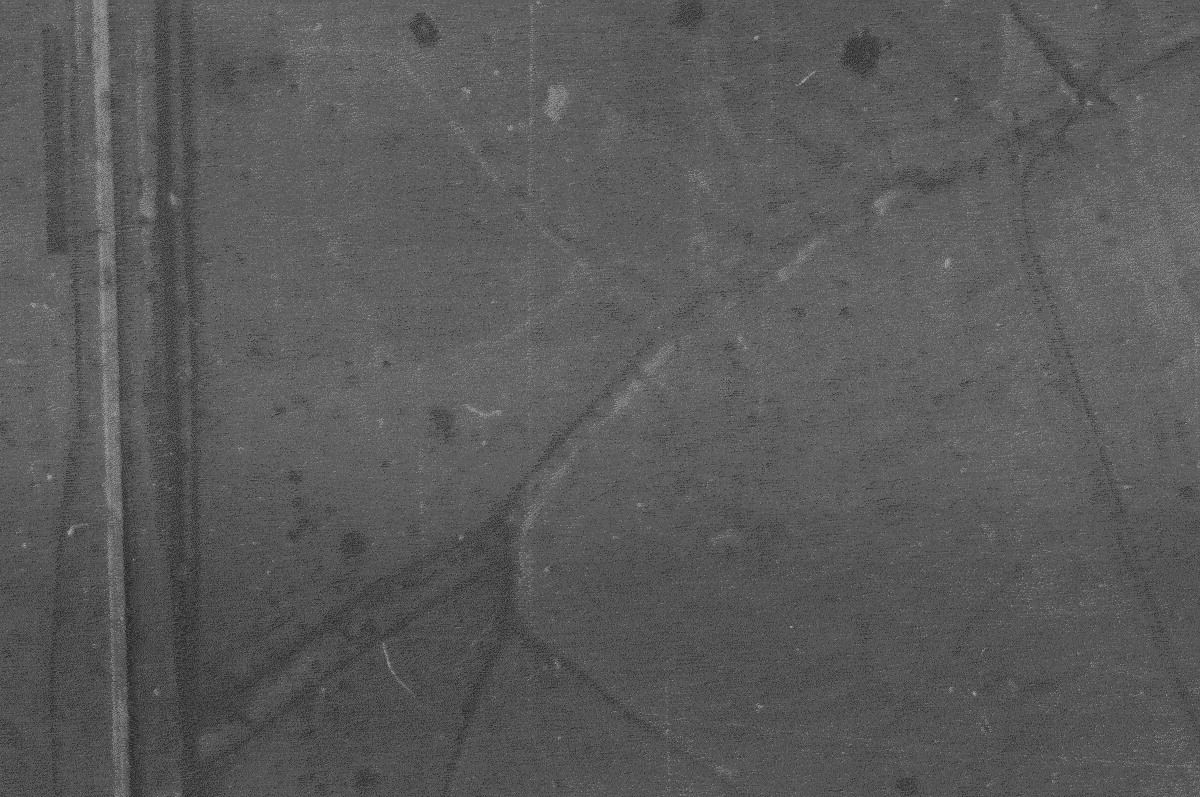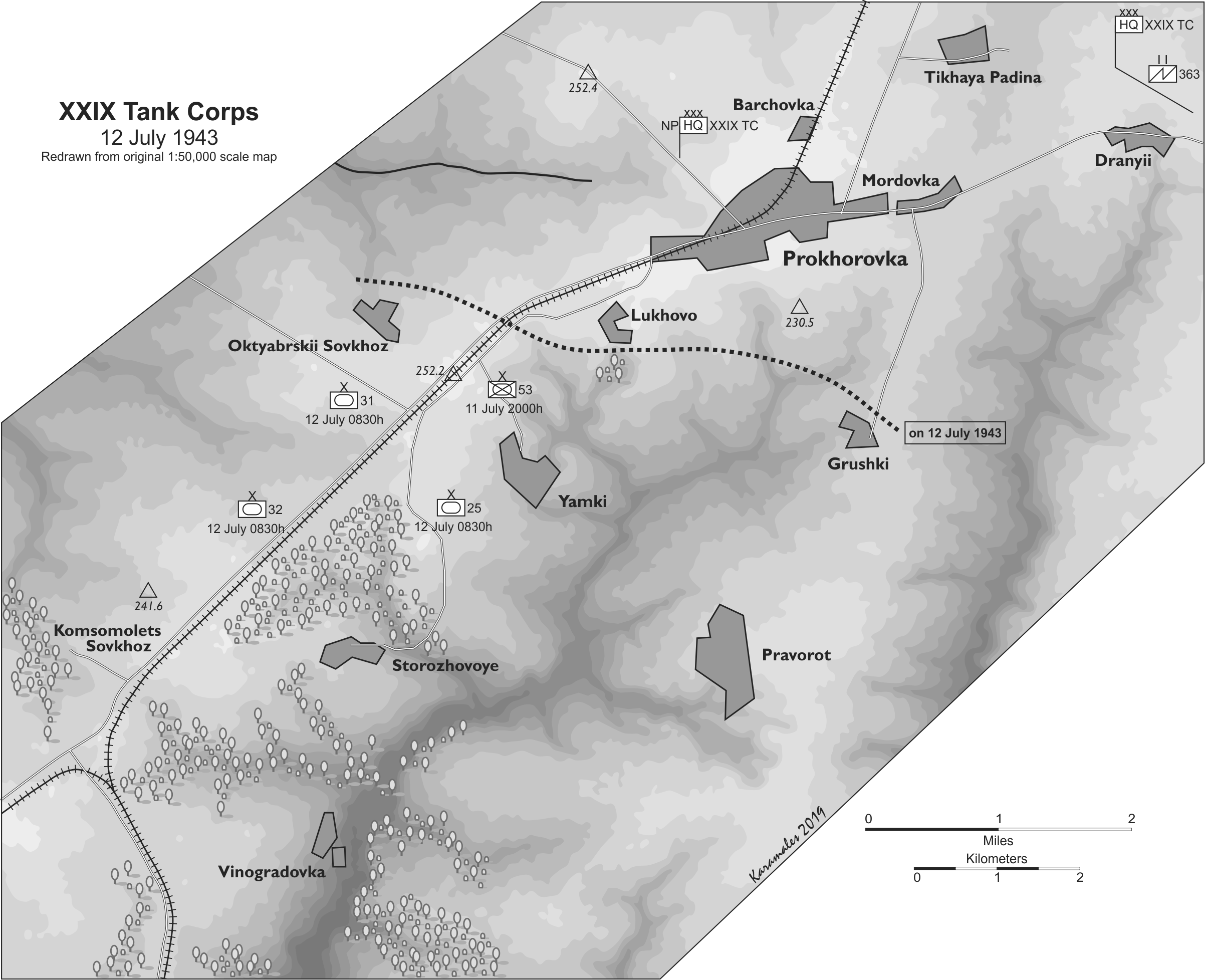
The XVIII Tank Corps attacked on the morning of 12 July with two tank brigades in the lead, the 181st and the 170th. It was supported by 32nd Motorized Rifle Brigade. Further back, initially in reserve was the 32nd Guards Tank Regiment (armed with Churchill tanks) and their 110th Tank Brigade, which also took some losses this day. So the question is, where did these units end up going?
The Plan of Attack
From 18th Tank Corps Account covering 12-24 July (post-battle account):
The first echelon (181st and 170th tank brigade) is to attack the enemy, with the task of taking Malye Maiachki….
The second echelon (32nd MotRBde, with an artillery group consisting of 292nd Mortar Rgt, a 76mm antitank artillery regiment and a 57mm antitank artillery regiment) is to attack behind the first echelon, and by the end of the day relieve the 181st and 170th Tank Brigades.
36th Guards Tank Regiment is to attack behind the 170th Tank Brigade in the second echelon, securing the corps’ right flank….
The third echelon (110th Tank Brigade and a reconnaissance detachment) are to reach the area of ht. 251.2 by the end of the day.
Corps HQ is in the third echelon between 110th TBde and the reconnaissance detachment.
An artillery group, consisting of 292nd Mortar Rgt, 80th Gds Mortar Rgt [Katyushkas], and a tank group, consisting of 100th ATArtRgt and 36th Gds TRgt, has orders to support the corps’ infantry-tank attack.
The brigade are following in the third echelon under protection of 110th TBde.
So, it appears that the initial attack was led by the two tank brigades and supported by the 32nd Motorized Rifle Brigade.
Corps Actions During the Day: The same report then notes:
The terrain in the corps’ attack zone is cut by three deep ravines, stretching from the left bank of the Psel River to the Belenikhino-Prokhorovka railroad, which is why 181st and 170th Tank Brigades, advancing in the first echelon, were forced to attack on the corps’ left flank near the enemy strong point at Oktyabrskii Sovkhoz. The 170th Tank Brigade, attacking on the left flank, by 1200 had lost 60% of its equipment.
Despite these losses, overcoming the enemy’s fire resistance, the corps’ units took the Oktyabrskii Sovkhoz and by 1200 were fighting along the line: …..
So it appears that the 170th Tank Brigade was on the left flank. The 181st Tank Brigade may have been biased to its right and in front of it. Not sure the 170th Tank Brigade ever got much beyond the Obtyabrskii Sovkhoz.
The corps’ units, continuing to carry out their mission, by the end of the day had reached the line 200 meter east of the Bogoroditskoye church–southern outskirts of Vasilevka-Andreyevka–two windmills at Preselstnoye–further along the northern slopes of the ravine southeast of Andreyevka-the Oktyabrskii Sovkhoz….
18 TC encounter the enemy’s well-organized and powerful anti-tank defense, consisting of tanks and assault guns along the line of ht. 217.9–ht. 241.6.
From Combat Report #37, 1400, July 12, 1943
The enemy is putting up stubborn resistance and is falling back in the pt. 217.9–Komsomolets Sovkhoz direction. Enemy artillery is firing intensively on our troops from the Greznoye area….Our neighbor on the left [XXIX Tank Corps] is fighting for Komsomolets Sovkhoz.
From Combat Report #38, 0300, July 13, 1943
In attempting to reach the Belgorod highway, 18th TC unexpectedly ran into the enemy’s well-organized resistance, which featured buried tanks and assault guns along the line ht. 217.9–ht. 241.6….
I have ordered the corps’ units to go over to the defensive along the following lines:….
From Fifth Guards Tank Army Operational Report #1, 1900, July 12, 1943.
18th TC, with 80th Gds Mortor Rgt [Katyushas], advancing from the line Prelestnoye-Prokhroovka, by 1400 captured Mikhalovka.
At 1400 the corps repulsed an enemy counterattack by 50 tanks from the Bogoroditskoye area, and by 13 “Tigers” from the area of ht. 226.6.
The corps’ further advance was contained by the enemy’s powerful artillery and mortar fire from the Greznoye area, and by tank fire from the Bogoroditskoye area.
Note that this counterattack by 50 tanks seems to be missing in most primarily German-based accounts. Not sure if it occurred. On the other hand, these last two paragraphs do put German tanks in Vasilyevka.
From Fifth Guards Tank Army Operational Report #2, 1700, July 13, 1943.
18th TC, with the 80th Gds Mortar Rgt, by the end of July 12 had taken the eastern outskirts of Vasilyevka, but its further advance was halted by the enemy’s artillery and tank fire from the area of the western outskirts of Vasilevka. The corps is on the line Petrovka-Mikhailovka and has consolidated and is regrouping.
From Fifth Guard Army Report from July 7-24, 1943 (prepared 30 September 1943):
170th and 181st Tank Brigades were to attack….and by 1430, after fierce fighting, had taken the Oktyabrskii Sovkhoz and had reached Andreyevka and Vasilyevka, an advance of 6-7 kilometers.
At 1330 the first-echelon brigades were fired on by 13 “Tiger” tanks from the area of ht. 226.6, which were moving in the direction of the northwestern outskirts of Mikhailovka.
At 1800 on July 12 the corps’ brigades finally took Vasilevka and reached Kozlovka.
The corps, on the line ht. 219.9–3 km southwest of Kozlovka–ht. 241.6, encountered heavy enemy fire resistance from assault guns, tanks buried in the ground, and fierce aerial bombardment, which made any further advance impossible.
The corps commander orders his units to consolidate along the line achieved and organize an all-around defense; 32nd MotRBde and 170th TBade, with the remains of 36th Gds TBde, in the center of Vasilyevka–Mikhailovka–Prelestnoye area; 181st TBde in Petrovka; 110th TBde in the (excl.) Petrovka–Beregovoye area.
181st Tank Brigade:
From XVIII Tank Corps Account covering 12-24 July (post-battle account):
…by 1200 were fighting along the line: 181st TBde Andreyevka-ht. 241.6
From Combat Report #37, 1400, July 12, 1943
181st TBde: Occupied Okyabrskii Sovkhoz and is fighting along the line Andreyevka-ht. 241.6.
From Combat Report #38, 0300, July 13, 1943
…181st Tank Brigade: Petrovka area
From Fifth Guard Army Report from July 7-24, 1943 (prepared 30 September 1943):
In Andreyevka 181st TBde met a large column of enemy tanks. As a result of the battle that followed, the Germans suffered heavy casualties and were thrown back on Kozlovka.
Note that this puts the 181st Tank Brigade at the front of the Corps and in Andreyevka.
170th Tank Brigade:
From XVIII Tank Corps Account covering 12-24 July (post-battle account):
The 170th Tank Brigade, attacking on the left flank, by 1200 had lost 60% of its equipment.
….by 1200 were fighting along the line:….170th TBde the ravine southeast of Mikhalilovka
From Combat Report #37, 1400, July 12, 1943
170th TBde: fighting along the line of the ravine southeast of Mikhailovka.
32nd Motorized Rifle Brigade:
….by 1200 were fighting along the line:…..32nd MotRBde was fighting for Andreyevka.
From Combat Report #38, 0300, July 13, 1943
….32nd MotRBde, with the 110th TBde and 36th Gds TRgt,: the area of the center of Vasilyevka–Mikhailovka–Prelestnoye
Other units:
From Combat Report #37, 1400, July 12, 1943
110th TBde: 500 meters east of Mikhailovka.
Headquarters is on the northern outskirts of Petrovka.
From Combat Report #38, 0300, July 13, 1943
…110th TkBde: the (excl.) Petrovka-Bergovoye area.
….1694th AA ArtRgt is to cover the defensive area from enemy air attacks, having its main firing positions in the Beregovoye area.
From Fifth Guard Army Report form July 7-24, 1943 (prepared 30 September 1943):
36th Gds TRgt encountered heavy fire from “Tigers” and AT guns from the ravines 2 km south of Mikhalovka, where it suffered heavy casualties.
This last account may be a reference to this LSSAH Tiger tanks.
Needless to say, these accounts do not support a narrative that the 181st and 170th Tank Brigade were primarily engaged with 4 Tigers at height 241.6. In fact, they don’t support the narrative that they penetrated the German positions, then the German reconnaissance battalion, and then engaged the German artillery. Because of (one?) German post-war interview(s) and the German intelligence map created at the time, we do believe there was such a penetration. This penetration may well have been only a part of one brigade.
It is also not certain if the 170th Tank Brigade ever got beyond the ravine southeast of Mikhailovka.




